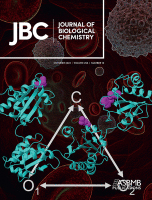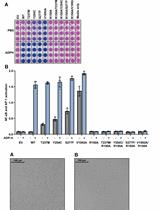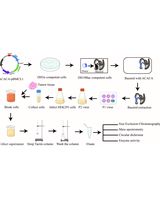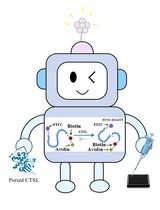- EN - English
- CN - 中文
A Direct in vitro Fatty Acylation Assay for Hedgehog Acyltransferase
猬酰基转移酶的直接体外脂肪酰化测定
发布: 2022年12月20日第12卷第24期 DOI: 10.21769/BioProtoc.4573 浏览次数: 1281
评审: Gal HaimovichQin TangAnonymous reviewer(s)
Abstract
Several assays have been developed to monitor the in vitro catalytic activity of Hedgehog acyltransferase (Hhat), an enzyme critical to the Hedgehog signaling pathway in cells. However, the majority of these previously reported assays involve radioactive fatty acyl donor substrates, multiple steps to achieve product readout, or specialized equipment. To increase safety, efficiency, and convenience, we developed a direct, fluorescent in vitro assay to monitor Hhat activity. Our assay utilizes purified Hhat, a fluorescently labeled fatty acyl-CoA donor substrate, and a Sonic hedgehog (Shh) peptide recipient substrate sufficient for fatty acylation. The protocol is a straightforward process that yields direct readout of fatty acylated Shh peptide via fluorescence detection of the transferred fatty acyl group.
Graphical abstract

Graphical abstract adapted from Schonbrun and Resh (2022)
Background
The Hedgehog (Hh) pathway plays an essential role in embryonic development and in multiple cancers in adults. Signaling is mediated by the secretion of Hh proteins, e.g., Sonic hedgehog (Shh), ultimately resulting in the activation of GLI transcription factors and expression of Hh pathway target genes. An essential component of the signaling pathway is the enzyme Hedgehog acyltransferase (Hhat), which catalyzes the transfer of palmitate as well as other fatty acyl groups to the N-terminal cysteine of Hh proteins (Schonbrun and Resh, 2022). This post-translational modification has been shown to be required for Hh signaling (Micchelli et al., 2002;Chen et al., 2004).
Hhat is a member of the membrane-bound O-acyltransferase enzyme family and is localized in the membrane of the endoplasmic reticulum. To date, several assays have been reported to measure the catalytic activity of Hhat in vitro. However, some of these assays rely on the use of radioactive substrates (Buglino and Resh, 2008; Jiang et al., 2021), which have safety hazards and require specialized waste disposal. Others require specialized equipment (Lanyon-Hogg et al., 2017) or multiple steps (Lanyon-Hogg et al., 2015) to achieve product readout, or measure a change in fluorescence anisotropy conferred by fatty acylation of a fluorescently conjugated Shh peptide (Lanyon-Hogg et al., 2019; Andrei et al., 2022). We set out to develop a straightforward, fluorescence-based assay to quantify the catalytic activity of purified Hhat in vitro by directly monitoring the transfer of a fluorescently labeled fatty acid to Shh. This protocol has the advantage of allowing for unambiguous competition analysis with other fatty acyl-CoAs (in addition to competition analysis with alternative forms of Shh substrate), by including these unlabeled substrates in the reaction. The two labeled substrates, biotinylated Shh peptide and NBD-labeled fatty acyl-CoAs (as well as the corresponding, unlabeled compounds for competition analysis) are readily obtained from commercial sources. Our assay is sensitive and specific and can potentially be adapted to a high-throughput format using a streptavidin-coated multi-well plate to capture the biotinylated Shh substrate.
Materials and Reagents
0.5 mL tubes (RPI, catalog number: 145505)
Black side, transparent bottom 96-well plate (Thermo Scientific, catalog number: 265301)
Biotinylated Shh peptide [CGPGRGFGKR-(PEG2)-K(Biotin)-NH2] [Anaspec and Peptide 2.0, custom synthesis, PEG2 = Fmoc-NH-PEG2-CH2-COOH; M.W. (theoretical) 1532.82 g/mol, order at least 5 mg, free N-terminus, NH2 at C-terminus, trifluoroacetate salt, QC analysis by MS and >95% purity by peak area on HPLC (220 nm, C18 column, Buffer A: 0.05% TFA in H2O, Buffer B: 0.05% TFA in 90% CH3CN, linear gradient 10%–35% B in 25 min] (store at a minimum of -20 °C)
Nitrobenzoxadiazole (NBD)-fatty acyl-CoAs (Avanti, catalog numbers: 810229P and 810705P) (store aliquots at a minimum of -20 °C)
n-Dodecyl-β-D-maltopyranoside (DDM) (Anatrace, catalog number: D310) (store at -20 °C)
3× FLAG® peptide (Millipore Sigma, catalog number: F4799) (store at -20 °C)
n-Octyl-β-D-glucopyranoside (OG) (EMD Millipore, catalog number: 494459) (store at room temperature)
Triton X-100 (Fisher Scientific, catalog number: BP151-500) (store at room temperature)
MES (Fisher Scientific, catalog number: BP300-100) (store at room temperature)
DTT (Promega, catalog number: V3151) (store aliquots at -20 °C)
PierceTM high-capacity streptavidin beads (Thermo Scientific, catalog number: 20361) (store at 4 °C)
Purified Hhat and mock purified eluate or elution buffer (see Recipes) (Schonbrun and Resh, 2022) (store at -80 °C)
Reaction buffer (see Recipes)
Wash buffer (see Recipes)
Equipment
Fluorescence plate reader (BioTek Synergy H1)
Refrigerated tabletop microcentrifuge (Eppendorf Centrifuge, model: 5417R)
PicoFuge (Stratagene)
Vacuum aspirator with attached 26½ G needle (Becton Dickinson, catalog number: 305111)
Repeat or regular pipettors
Software
Gen5 (BioTek)
Excel (Microsoft)
Prism (GraphPad)
Procedure
文章信息
版权信息
© 2022 The Authors; exclusive licensee Bio-protocol LLC.
如何引用
Schonbrun, A. R. and Resh, M. D. (2022). A Direct in vitro Fatty Acylation Assay for Hedgehog Acyltransferase. Bio-protocol 12(24): e4573. DOI: 10.21769/BioProtoc.4573.
分类
癌症生物学 > 癌症生物化学 > 蛋白质
生物化学 > 蛋白质 > 活性
您对这篇实验方法有问题吗?
在此处发布您的问题,我们将邀请本文作者来回答。同时,我们会将您的问题发布到Bio-protocol Exchange,以便寻求社区成员的帮助。
Share
Bluesky
X
Copy link













